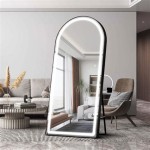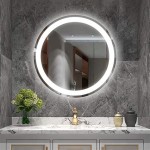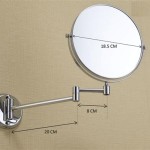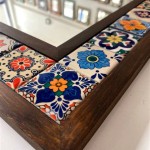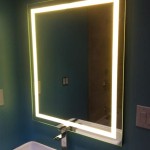Traditional Bathroom Mirrors: A Timeless Elegance
The bathroom, once a purely functional space, has evolved into a sanctuary for relaxation and self-care. Within this transformation, design elements play a crucial role, and the bathroom mirror is paramount. While modern styles frequently dominate design trends, traditional bathroom mirrors maintain a steadfast appeal, offering a sense of timeless elegance and sophistication. Their enduring popularity stems from their ability to seamlessly blend with a variety of bathroom aesthetics, bringing warmth, character, and a touch of history into the space. This article explores the key features, benefits, and considerations when selecting a traditional bathroom mirror.
Traditional bathroom mirrors are often characterized by their ornate frames, intricate detailing, and the use of classic materials. These design elements evoke a sense of history and craftsmanship, setting them apart from minimalist, contemporary styles. The appeal lies in the mirror's ability to act as a focal point, drawing the eye and adding a layer of visual richness to the bathroom decor.
Key Features of Traditional Bathroom Mirrors
Several distinctive attributes define traditional bathroom mirrors. Understanding these features is key to selecting a mirror that complements the overall design of the bathroom and meets individual preferences.
Framing: Elaborate frames are a hallmark of traditional bathroom mirrors. These frames are often crafted from wood, although materials like metal, particularly brass and wrought iron, are also common. Wood frames can be stained, painted, or left unfinished to enhance the natural grain. Common frame styles include beveled edges, raised panels, and intricate carvings. The choice of frame material and style significantly impacts the mirror's overall aesthetic.
Shape and Size: While rectangular and oval shapes are common in traditional mirrors, variations such as arched tops or asymmetrical designs are also prevalent. The size of the mirror should be proportionate to the vanity and the overall dimensions of the bathroom. A large mirror can create the illusion of a more spacious room, while a smaller mirror may be better suited for a smaller bathroom or powder room.
Material and Finish: The materials used in traditional bathroom mirrors directly contribute to their aesthetic and durability. High-quality wood like mahogany, cherry, or oak are frequently employed for frames, offering both beauty and longevity. Metal frames, often finished in polished brass, antique bronze, or oil-rubbed bronze, provide a touch of elegance and sophistication. The mirror glass itself is typically of high quality, often beveled to add depth and visual appeal.
Lighting: While not inherent to the mirror itself, the integration of appropriate lighting is crucial for enhancing the functionality and aesthetic appeal of a traditional bathroom mirror. Sconces flanking the mirror, or a decorative light fixture positioned above it, can provide ample illumination for grooming and create a warm, inviting ambiance. The style of the lighting fixtures should be carefully chosen to complement the traditional style of the mirror.
Benefits of Incorporating Traditional Bathroom Mirrors
Choosing a traditional bathroom mirror offers several advantages, ranging from aesthetic enhancements to functional improvements. Consider these benefits when making a selection for a bathroom renovation or upgrade project.
Timeless Appeal: Traditional designs are not bound by fleeting trends. A well-chosen traditional bathroom mirror will remain stylish and relevant for years to come, offering a lasting aesthetic investment. Its inherent classicism allows it to transcend temporary fads, ensuring the bathroom maintains a refined and elegant atmosphere.
Enhanced Aesthetics: The ornate details and craftsmanship of traditional mirrors add a layer of visual interest and sophistication to the bathroom. They act as a focal point, drawing the eye and elevating the overall design. These mirrors can transform an otherwise ordinary space into a visually appealing and inviting environment.
Versatility: While traditionally associated with classic or Victorian-style bathrooms, traditional mirrors can also be effectively incorporated into other design schemes. They can add a touch of warmth and character to a modern bathroom, or complement a transitional style that blends traditional and contemporary elements. The key is to carefully select a mirror that harmonizes with the existing decor.
Increased Perceived Space: Like all mirrors, traditional bathroom mirrors can help create the illusion of a larger space. A strategically placed mirror can reflect light and create depth, making a small bathroom feel more open and airy. The choice of size and placement is crucial for maximizing this effect.
Personal Expression: Traditional bathroom mirrors are available in a wide range of styles, finishes, and sizes, allowing for a high degree of personalization. Individuals can select a mirror that reflects their personal taste and complements the overall aesthetic of their home. This ability to customize the mirror ensures it truly becomes a unique and cherished element of the bathroom.
Considerations When Selecting a Traditional Bathroom Mirror
Choosing the right traditional bathroom mirror requires careful consideration of several factors, including size, style, functionality, and cost. By addressing these considerations, one can ensure that the selected mirror meets their needs and enhances the overall design of the bathroom.
Size and Proportion: The mirror should be appropriately sized for the vanity and the overall dimensions of the bathroom. A mirror that is too small will look insignificant, while a mirror that is too large may overwhelm the space. As a general rule, the mirror should be slightly narrower than the vanity. Consider the height of the ceiling and the placement of other fixtures when determining the appropriate size.
Style Compatibility: The style of the mirror should complement the overall design of the bathroom. Consider the existing color palette, hardware finishes, and architectural details. A traditional mirror with a heavily ornate frame may not be suitable for a minimalist bathroom, while a simple, understated mirror may not be impactful enough for a Victorian-style bathroom. Strive for a cohesive and harmonious design.
Lighting Integration: Proper lighting is essential for both functionality and aesthetics. Consider the placement of light fixtures and how they will interact with the mirror. Sconces mounted on either side of the mirror provide even illumination for grooming, while an overhead fixture can add ambient lighting. Ensure that the lighting style complements the traditional style of the mirror.
Material Quality and Durability: Select a mirror made from high-quality materials that are resistant to moisture and humidity. Wood frames should be properly sealed to prevent warping or water damage, while metal frames should be rust-resistant. The mirror glass should be of good quality and free from imperfections. Investing in a durable mirror will ensure it lasts for years to come.
Budget: Traditional bathroom mirrors can range in price from relatively affordable to quite expensive, depending on the materials, craftsmanship, and design. Set a budget before beginning the search and stick to it. Consider the long-term value of the mirror and be willing to invest in quality if necessary. It’s often more cost-effective to purchase a higher-quality mirror that will last for many years than to replace a cheaper one frequently. Consider online retailers, antique stores, and local artisans to explore a variety of options within different price ranges.
Installation: Some traditional bathroom mirrors may require professional installation, particularly those with heavy frames or integrated lighting. Factor in the cost of installation when budgeting for the project. Ensure that the mirror is securely mounted to the wall to prevent accidents. If installing the mirror yourself, carefully follow the manufacturer's instructions and use appropriate hardware.
Maintenance: Traditional bathroom mirrors often require more maintenance than modern, minimalist designs. Ornate frames can accumulate dust and require regular cleaning. Use a soft cloth and a mild cleaning solution to avoid damaging the finish. Avoid abrasive cleaners that can scratch the mirror glass or the frame. Periodic polishing may be necessary to maintain the luster of metal frames.
In conclusion, traditional bathroom mirrors offer a timeless elegance and sophisticated aesthetic that can enhance any bathroom. By carefully considering the key features, benefits, and considerations outlined above, one can select a mirror that meets their needs and complements the overall design of their bathroom. The result will be a space that is both functional and beautiful, a true sanctuary for relaxation and self-care.

Antique Mirrors In A Bathroom Adding Charm Character

Traditional Bathroom Mirror With Light In 2024 Mirrors Lights

20 Best Bathroom Mirror Ideas Designs For Sinks And Vanity

51 Bathroom Mirrors To Complete Your Stylish Vanity Setup

51 Bathroom Mirrors To Complete Your Stylish Vanity Setup

Mirror Guide How To Choose A Bathroom Kohler

Decorative Bathroom Mirrors 8 Advantages And Disadvantages

27 Bathroom Mirror Ideas For Every Style Wall Decor
:max_bytes(150000):strip_icc()/traditional-bathroom-5a20b500b39d030039371da9.jpg?strip=all)
13 Beautiful Mirrored Bathrooms

Hanging A Mirror Versus Built In One Will Save You Big Bucks And Allows To E Bathroom Makeover Design Traditional Mirrors

